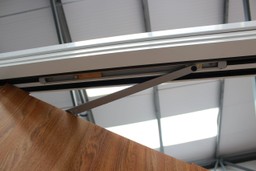What is a Residential Fire Door? Improving Home Fire Safety
A residential fire door is a door designed specifically to resist fire and smoke, slowing down their spread through a building. These doors are key components in passive fire protection systems, which allow for safe escape routes and buy potentially life-saving time to escape during a fire. Typically required by building codes in multi-story homes… Continue reading What is a Residential Fire Door? Improving Home Fire Safety
A residential fire door is a door designed specifically to resist fire and smoke, slowing down their spread through a building. These doors are key components in passive fire protection systems, which allow for safe escape routes and buy potentially life-saving time to escape during a fire. Typically required by building codes in multi-story homes and high-risk areas, residential fire doors not only prevent fires from spreading quickly but also help keep occupants and property safer.
Here, we delve into every aspect of fire doors in residential properties, from their construction to installation, maintenance, and beyond.
Key Takeaways
- Fire Resistance Ratings: Fire doors are rated as FD30 or FD60, indicating that they can withstand fire for 30 or 60 minutes respectively.
- Construction: They’re built from dense, fire-resistant materials like timber or steel, with solid cores.
- Sealing Mechanisms: They’re equipped with intumescent strips that seal gaps in a fire.
- Compliance: These doors must adhere to specific regulatory standards.
- Role in Safety: They provide crucial time for evacuation and limit property damage.
What is a Residential Fire Door’s Purpose?
A residential fire door functions as a barrier, blocking fire and smoke to limit damage and provide additional time for evacuation. It’s part of a passive fire protection system, which is distinct from active systems (like fire alarms and sprinklers) because it doesn’t require activation to perform its role. Instead, it’s always working to contain fire in specific zones, enabling safe escape paths.
Related Reading: Visit our Advanced Flat Entrance Fire Doorsets page to learn more about fire doors specifically designed for residential properties.
Key Features of Residential Fire Doors
Now we know what a residential fire door is for, let’s discuss how it is rated. These doors are typically labelled FD30 or FD60, showing they can hold back fire for 30 or 60 minutes, respectively. For most residential buildings, FD30 ratings are sufficient, although certain high-risk properties may require FD60-rated doors.
Fire doors are built using materials like solid timber, steel, or fire-resistant composites. The solid core within the door structure is crucial for its resistance to fire and high temperatures, providing enhanced durability and ensuring the door does not weaken quickly under intense heat.
Safety Components and Sealing Mechanisms
What are a residential fire door’s core components? These doors rely on fire-rated hardware—such as hinges, handles, and automatic closers—to perform effectively in an emergency. Automatic closers, for example, allow the door to shut immediately if it’s left open, maintaining its fire-resistant barrier.
For a comprehensive comparison of internal fire door sets, explore our Internal Fire Door Set Comparison page.
Compliance and Installation Standards
In multi-story residences, fire doors are often made mandatory by building codes, and so must be installed in key areas, such as stairwells and internal garages. Compliance ensures that residential fire doors adhere to critical safety and durability standards.
Note: Fire doors installed in homes must meet local safety codes. Check against your local regulations to ensure compliance, as fines can apply for non-compliance in multi-story buildings.
Fire Door Installation and Placement
Correct installation is essential for fire doors to perform their role effectively. Placement is often determined by building codes, which may require doors to be installed at exits or between floors. Improper installation or damage to the door structure can severely reduce its fire resistance, so always consult certified professionals for installation.
Fire Door Maintenance and Inspection Tips
Fire doors should be inspected regularly to ensure they remain functional. Inspections include checking the intumescent strips, verifying that the door closes fully and automatically, and ensuring that all hardware is intact. Frequent testing and maintenance ensure fire doors remain effective over time and are ready in the event of an emergency.
Maintenance Tip: Schedule regular professional fire door inspections (the frequency will depend on the type of fire door) to ensure that all components are in proper working condition.
Common Maintenance Practices
Maintenance tasks include tightening loose hinges, cleaning door surfaces, and replacing any damaged intumescent strips. Additionally, routine inspections should ensure that fire doors are not blocked by furniture or other objects, as this can prevent them from closing fully and limit their effectiveness during a fire.
Discover more about fire door compliance on our Intro to Fire Door Compliance page.
Enhancing Fire Safety in Residential Spaces
The primary role of residential fire doors is to provide a barrier that limits fire and smoke spread, giving residents valuable extra time to escape. They also protect property by isolating the fire, which can reduce structural damage in the long term. This is especially important for multi-story buildings, where the containment of fire on one level can prevent it from spreading to others.
For optimal fire safety, pairing fire doors with other fire protection measures, such as smoke detectors, offers an added layer of security, creating a comprehensive approach to fire safety within residential settings.
Residential fire doors are essential for creating safe and compliant living spaces, designed to safeguard lives and reduce the damage that fire can cause. Following the above guidelines will ensure that residential properties are equipped with fire doors that function as reliable barriers to fire and smoke in times of need.
Frequently Asked Questions
What is a residential fire door?
A residential fire door is designed to prevent fire and smoke from spreading quickly through a home, providing protection and safer exit routes during emergencies.
Why are fire doors important for homes?
Fire doors delay fire spread, giving residents additional time to evacuate and preventing extensive property damage.
How long do residential fire doors resist fire?
This depends on what a residential fire door is rated for – however, most are rated to withstand fire for either 30 minutes (FD30) or 60 minutes (FD60), depending on the home’s requirements.
Where should fire doors be installed in homes?
In multi-story buildings, fire doors should be installed between stairwells and habitable rooms, and between internal garages and main living areas.
How often should fire doors be inspected?
Residential fire doors should be inspected at least every 6 months to ensure they function correctly, with a focus on intumescent seals, hinges, and automatic closers.
What materials are used in residential fire doors?
They are typically constructed from solid timber, steel, or fire-resistant composites, each chosen for its durability and compliance with fire safety standards. Gerda Security fire doors use engineered timber in our Safer Homes range, and insulated steel in our Contemporary range.




